Many sewers both new and experienced are unnecessarily scared of sewing stretch knit fabrics.
Most knit-phobes believe these popular myths about sewing knits:
- I need to use an overlocker to sew knit fabrics
- I can’t sew knit fabrics on my sewing machine
- knit fabrics are harder to sew than delicate silk fabrics
- knit fabrics have to be stretched when I sew them
- it’s hard to cut out knit fabrics accurately
- I won’t be able to get seams to match accurately using knit fabrics
- it’s difficult to buy nice knit fabrics
- I don’t want to make really tight figure hugging clothes.
None of these statements are true! Let’s go through them again and tell you the truth:
- No, you don’t need to have an overlocker to sew knit fabrics. You can and an overlocker will make the job quicker, easier and neater, but if you’ve never used an overlocker before, definitely don’t start on one with a knit fabric!
- All reasonably modern sewing machines have a selection of stitches specifically designed for stretch knit fabrics. I’m going to show you the best ones for joining seams in this article. Even if your machine only does straight stitch and zig-zag a narrow zig-zag stitch will do the job.
- Some knit fabrics can be a bit more difficult to handle than a standard woven fabric, especially the lighter weight ones, but even a lightweight jersey isn’t going to be as difficult as a slippery lightweight silk. A few more pins when cutting out and a bit of tacking when you might just have pinned are the only extra steps you’ll need.
- I’ve actually seen this recommended in some of the bigger commercial pattern brand’s pattern instructions. This is absolutely the last thing to do unless you’re after stretched wavy seams!
- When cutting stretch knits you need to make sure the fabric isn’t hanging off your table because it will stretch the fabric, resulting in pattern pieces that ping up a lot shorter once you’ve cut them out! If you don’t have room for the whole length of fabric on your table, pile it up over the back of a chair beside the table. Also use a few more pins than you might do normally to hold your pattern pieces accurately in place. Using a few weights (or tins of beans!) to hold your pattern in place while you pin it will also help.
- To match seams accurately pin them first and if necessary tack them. Also use the nature of the fabric to your advantage…..it stretches, which means it’s very forgiving if something doesn’t quite match perfectly and you can get away with a bit of stretching to fit (as long as that bit of stretch is spread out along the whole of the seam).
- Have a read of my previous blog post about where to buy stretch knit fabrics, the different types of stretch knit fabrics available and their uses – knit fabric is a broad category.
- You can make some really flattering, draped styles using stretch knits. They’re not just for leotards and leggings! Think about the clothes you own that you enjoy wearing…..I’ll bet a lot of them are made from knit fabrics.
So, hopefully I’ve made a start at converting you and you’re willing to have a try. The first thing I’ll show you is some stitches to use for seams. I’ll go through hems and finishing edges in separate posts.
NEEDLES
The first thing you need for any machine is:
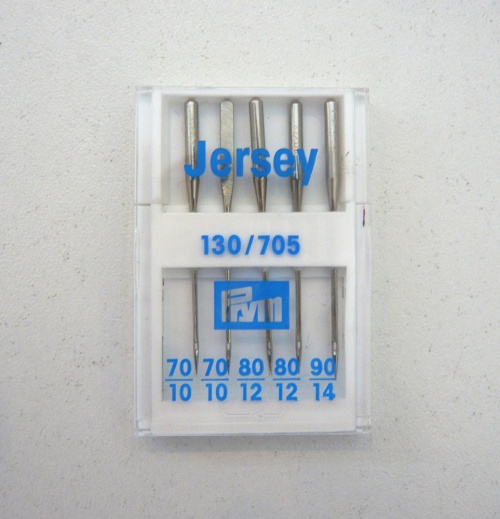 a pack of jersey or ballpoint needles. They’re a bit more blunt on the end than a regular sewing needle meaning that they won’t ladder the knitted structure of the fabric. You can see they also come in different sizes like regular sewing needles.
a pack of jersey or ballpoint needles. They’re a bit more blunt on the end than a regular sewing needle meaning that they won’t ladder the knitted structure of the fabric. You can see they also come in different sizes like regular sewing needles.
Here’s a guide for which size will best suit which fabric:
70 – very lightweight silk or viscose jersey
80 – light t-shirt weight cotton jersey
90 – interlock, ponte roma, some cut and sew knits.
MACHINE SETTINGS FOR SEAMS
The first and easiest stitch to use for seams is the stretch straight stitch:
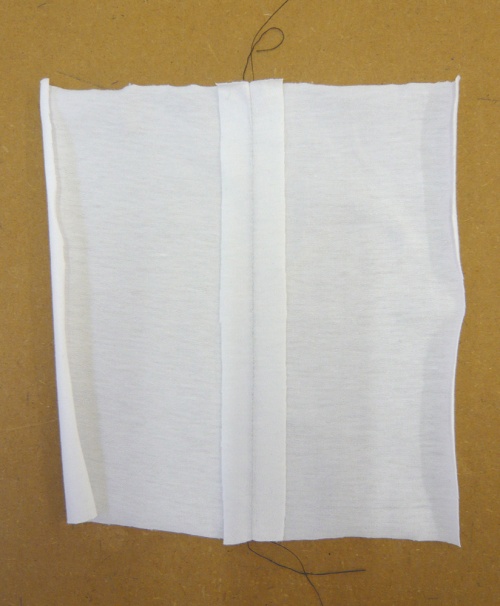 This stitch is useful when sewing with thicker knits whose edges don’t need any neatening and where you need to be able to press your seam open.
This stitch is useful when sewing with thicker knits whose edges don’t need any neatening and where you need to be able to press your seam open.
A stitch we use a lot for sewing knit fabrics in my classes is the overlock stitch:
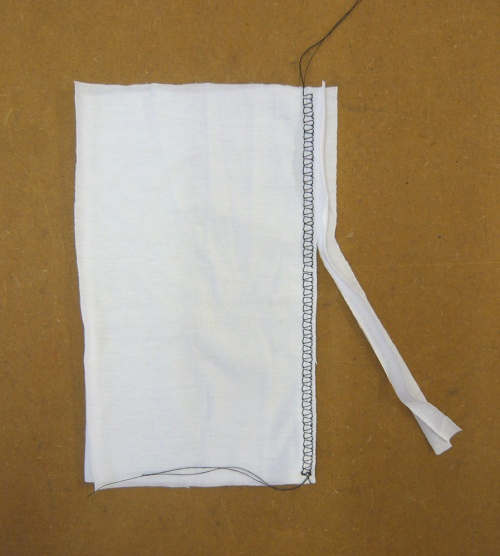 This stitch mimics an overlock stitch and can join the seam and neaten the edges in one go. You can trim off the excess seam allowance close to the stitching as shown in the second picture. The seam then has to be pressed flat to one side rather than open, so it’s not suitable for more bulky fabrics. It works well on most t-shirt weight jerseys.
This stitch mimics an overlock stitch and can join the seam and neaten the edges in one go. You can trim off the excess seam allowance close to the stitching as shown in the second picture. The seam then has to be pressed flat to one side rather than open, so it’s not suitable for more bulky fabrics. It works well on most t-shirt weight jerseys.
The final stitch for seams is the narrow overlock stitch used with an overcasting or overlock foot. (See this blog post for more about what an overcasting foot is and how to use it).
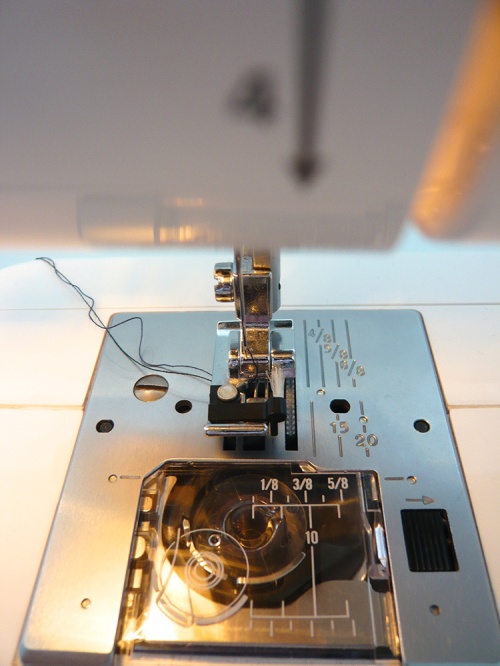 Here’s the machine with the overcasting foot attached.
Here’s the machine with the overcasting foot attached.
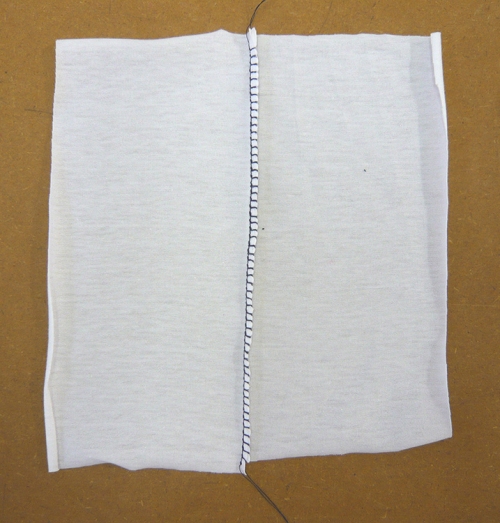 This stitch again joins the seam and neatens the edge of the seam allowance in one go. By also using the overcasting foot it means you don’t need to then trim off the excess seam allowance after sewing. It also means though that you can only use it on narrow seam allowances (the overall width of the stitch). It’s another stitch that results in a seam that has to be pressed to one side and gives a nice neat finish to lightweight jersey fabrics. It’s not suited to heavier and thicker knits.
This stitch again joins the seam and neatens the edge of the seam allowance in one go. By also using the overcasting foot it means you don’t need to then trim off the excess seam allowance after sewing. It also means though that you can only use it on narrow seam allowances (the overall width of the stitch). It’s another stitch that results in a seam that has to be pressed to one side and gives a nice neat finish to lightweight jersey fabrics. It’s not suited to heavier and thicker knits.
PRESSER FOOT PRESSURE
If your sewing machine has the ability to adjust the presser foot pressure, this can be helpful when sewing some knit fabrics to stop them being stretched by the machine as you sew. You can read more about how to adjust the presser foot pressure in this blog post.
TENSION
As with all sewing, make sure the tension on your machine is set at the right level for the fabric you’re sewing. If your machine’s tension dial goes up to 9, 4 should be fine for joining two layers of most medium weight woven fabrics. A lower number means a looser stitch which you need for lighter weight fabric or fewer layers. A higher number means a tighter stitch which you need for thicker fabrics or more layers. You shouldn’t need to adjust the tension up or down by more than one number, meaning you will usually stay within the range of 3-5.
Most lighter weight knit fabrics eg. t-shirt jersey and lighter need a looser tension of around 3.
So there you are – how to sew seams in a range of knitted fabrics on your sewing machine. I hope you’re turning from a knit-phobe into a knit-fan! In my next article I’ll show you how to get nice hem finishes on knit fabrics using a sewing machine.



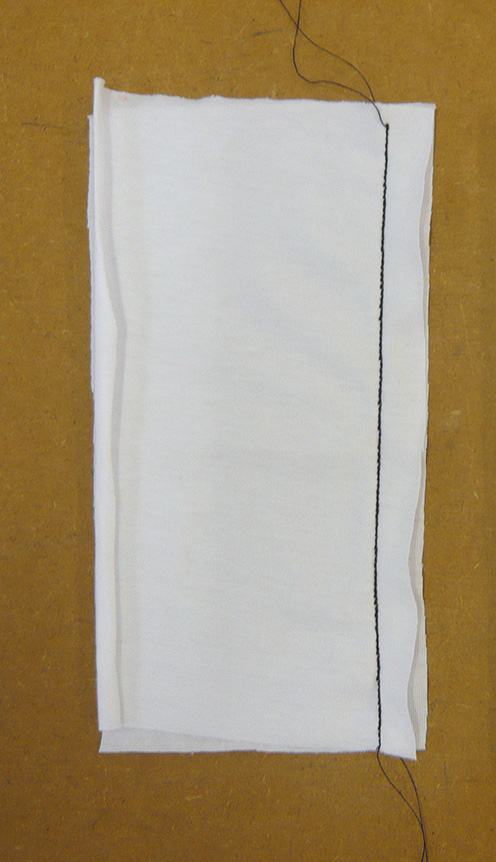
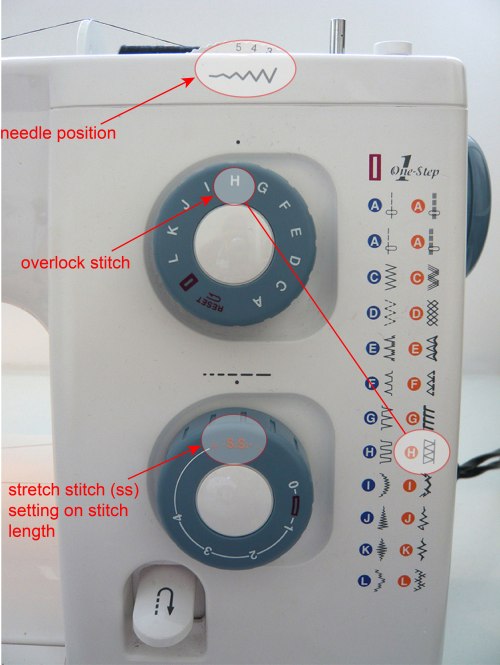
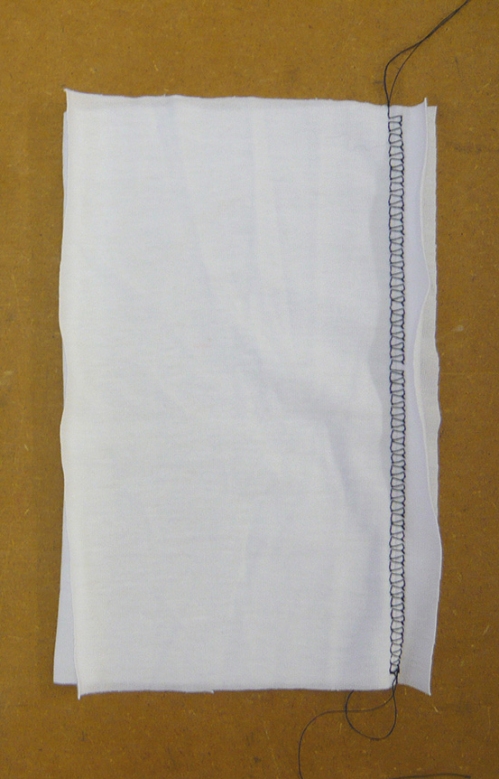
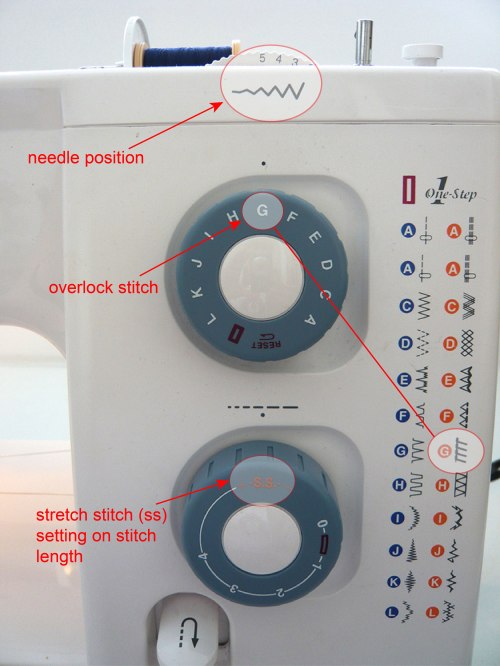
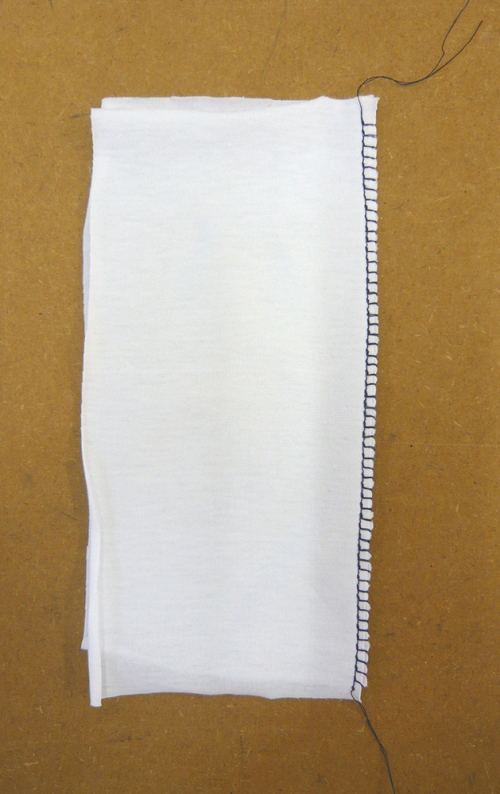
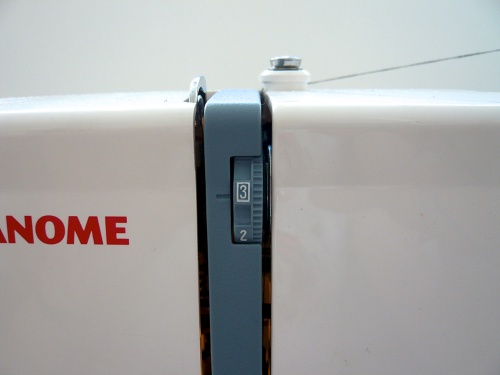
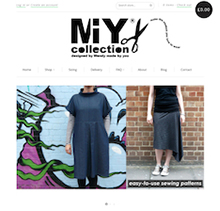




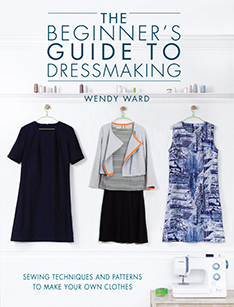










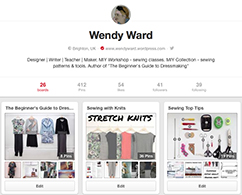

Hello Wendy. Just come across your really helpful website and at the weekend I attempted to sew a short skirt from Ponte on a regular domestic sewing machine (Brother LK14s) It sort of turned out okay so was quite pleased. Cutting out was a little tricky as it was a downloaded PDF pattern printed on copy paper not tissue paper pattern. One question. When you talk about a stretch straight stitch in your post could you clarify that a bit for me . Is it a special straight stitch on my stitches dial specifically for stretch fabrics or just the regular straight stitch? Obviously I should have used a straight stitch to sew the darts not a zigzig stitch as I couldn’t sew to the point !
LikeLike
Hi Liz, definitely sew darts with a straight stitch. There’s a photo within the blog post of the stretch straight stitch on this particular machine – it looks like a triple stitched straight stitch. Some machines also have a stitch that looks like a lightning bolt – this one is perfect if you have it – it’s much easier to unpick than the triple stitched one. Not that we like to think we’re going to need to unpick what we sew, but we all make mistakes sometimes! Hope that helps. Wendy
LikeLike
Very helpful my first t shirt went back to the cutting table but im going to try again I’ll let you know how it comes out
LikeLike
Glad it’s been helpful!!
LikeLike
Thank you Wendy, this is the most informative detailing I have seen, especially with pictures showing machine dials etc, I have a Janome machine, but am a long term, by that I mean I don’t try and sew very often, beginner-ish. Of course during this lockdown I think a lot of sewing machines have seen the light of day. Brilliant I found your info very good and will definitely give stretch fabric a go, as I saw a picture a lady had posted on Facebook of a brilliant every day dress, with pockets, that I quite fancy making for myself, albeit a little longer in length to just below the knee. Much appreciated.
LikeLike
So pleased to hear you’ve found it useful!
Happy sewing :o)
LikeLike
One of the most informative, straightforward post I came across. Thanks! Will get sewing now! 😁
LikeLike
Thank you!! Happy sewing 🙂✂️
LikeLike
Thank you for a very informative blog. I’ve only been sewing for a year now and the second major project I did was with stretch fabric, I wasn’t afraid of it as I didn’t know it was supposed to be difficult. But your post has cleared up some of the problems I encountered. (Like tension) wish I’d found your post early! Thank you.
LikeLike
Thanks so much, I’m pleased to hear my blog has been so helpful for you!!
LikeLike
Help Wendy!
I’ve tried sewing a lightweight jersey knit skirt but there are stitches missing and I’ve tried adjusting the tensions, stitch lengths etc but still no good, I’ve even tried a different thread.
Any ideas?
LikeLike
Try a fine ballpoint needle and reducing the presser foot pressure (or try a walking foot). Hope that helps! Keep going with it.
LikeLike
Many thanks for a prompt reply.
The fabric says it’s a 4 way stretch 95% polyester and 5% spandex, does this make any difference to the needle type?
LikeLike
No really. If your machine continues skipping stitches try a very fine (size 75 or 80) regular needle instead of ballpoint. Machines often skip stitches when the needle struggles to pierce the fabric so make sure you’re using fresh needles with each you try.
LikeLike
I’m on my way to buy some new needles now.
I won’t give in!
Thanks for being there to encourage us tryers.
LikeLiked by 1 person
Fingers crossed!
LikeLike
Very clear and straightforward.
LikeLiked by 1 person
This has been so useful, I just attempted my first pair of baby leggings…. I’ll definitely be putting some of these into practice next time!
LikeLike
Glad to hear it! Perfect quick project to practice on.
LikeLike
Hello – I just bought a dress made with stretchy fabric and notice that it also uses stretchy thread for sewing seams. I’ve decided to make a copy of it but could I use standard thread? Great article by the way – just what I needed. Thanks. Sue
LikeLike
Just use regular thread and a stretch stitch Sue – it will be fine! Enjoy.
LikeLike
I have bought some jersey fabric, and am going to try to make a simple dress from it on my very basic machine. Thanks so much for this post, Wendy – it will really help!
LikeLiked by 1 person
Happy sewing! Glad to hear you’ve found it so useful.
LikeLiked by 1 person
Thanks great tips 😀
LikeLike
Hi Wendy
i have an old machine from the 60s and it only has straight and zigzag stitches. I purchased a jersey needle, but after your post I have doubts – do I absolutely need an mimic overlock stitch to sew knits? Or will what I have suffice? Can I just sew a straight stitch with jersey needle?
The knit fabric I have is on the sturdier side and not a lightweight knit.
LikeLike
Hi Jenny, as explained in the post you don’t have to have an overlock stitch. If your machine only does straight and zigzag stitches I’d use a narrow zigzag, definitely not a regular straight stitch. Whether or not to use a jersey needle depends on the thickness of the fabric, I find anything thicker than ponte roma is better with a regular needle. To be sure, try the jersey needle, if you get skipped stitches swap over to a regular needle. Hope that helps and happy sewing!!
LikeLike
thank you! Just out of curiosity, which model of Janome is used in this post?
LikeLike
It’s a Sewist 525S.
LikeLike
If I have a janome 4030QDC where do I or how do I get a stretch stitch?
LikeLike
Hi Kennedy, I’m not familiar with that particular model, but most Janome machines have some or all of the stitch options mentioned in my post.
LikeLike
This is brilliant; thank you!
LikeLiked by 1 person
You’re welcome! Thanks :o)
LikeLike
Brilliant post, thankyou.
LikeLiked by 1 person
Thanks Liz glad you found it useful 😀
LikeLike
Thanks for your clear article. I am fairly new to sewing and have just ordered my first collection of patterns. I was worried as I do like tunics in stretch jersey fabrics but I am going to give it a try!
LikeLiked by 1 person
Thanks! Really pleased to hear my post has given you the confidence to have a go at jersey fabric. They’re not that tricky and I hope you get some good results, let me know! Wendy
LikeLiked by 1 person
This was so helpful and encouraged me enough to have a go with jersey. I’ve successfully made two tops which I’m really proud of and I’m now on my third – which has a loose cowl type neck. Unfortunately this time things have gone horribly wrong and the neck has stretched badly out of shape at the back. I’m not sure it can be rescued but would welcome any suggestions!
LikeLike
Hi Barbara, I’m so pleased to hear my post has encouraged you to successfully have a go at using jersey fabrics!
Without seeing the style of your cowl neck top I’m not totally sure what might be the problem, but to stop necks stretching out of shape try these methods:
1 – finish off the back neck with a folded band edge finish – have a look at the 3rd of my series on sewing knits for Sewing World magazine: https://wendyward.wordpress.com/2014/12/17/knits-know-how-series-hems/
2 – use some iron-on bias tape to stop the back neck stretching, find out more here: http://miycollection.co.uk/2012/08/07/a-secret-weapon-for-sewing-jersey-fabrics/
Hope that helps!
Wendy
LikeLike
Hi Wendy, thanks for replying so quickly – your suggestions will certainly help next time. The top I’m making has the wide collar attached to the neck of the top (and pressed as per pattern instructions, but I think that was where it all went wrong!) I then attached the facing with ironed on interfacing and turned that in – so the cowl is between the facing and the top. The cowl then turns out over the seam which has stretched badly out of shape. I’m thinking I could try the tape you mention and try re-attaching the collar after cutting off the stretched area. I have had a look on the internet to buy the tape – is it used for quilting normally? I can’t see one that’s recommended for jersey.
Thanks again for your help.
Barbara
LikeLike
Hi Barbara, I get mine from Vena Cava: http://www.venacavadesign.co.uk/shop/home/581-vilene-bias-tape.html it’s really soft and works beautifully for knits.
Hope that helps!
Wendy
LikeLike
Such a useful post. So comprehensive and clearly written. Thank you!
LikeLike
You’re welcome Em and thanks for your feedback which is good to hear! I hope you’re now off to sew some jersey fabric!! Wendy
LikeLike
Will be trying this soon, my son who is 9 wants to make his own summer clothes so i am hoping to start with some shorts, he will be designing and i will be stitching, hopefully it all works out well
LikeLiked by 1 person
Good luck, great teamwork!!
LikeLike
Thanks so much for the reply about the leggings. The little legs are so small I wouldn’t be able to do them after sewing the leg seams but I will definitely try your advice about starting on scrap fabric. I will be sewing some more soon and I will pop back and let you know how I get on. Thanks again.
LikeLike
You’re welcome Eileen, hope it helped a bit! Do let me know how you get on. Good luck. Wendy
LikeLike
Great information. I have always avoided stretch fabrics but recently bought a coverlock machine and I am slowly coming to grips with it. My question is about using an overlocker on stretch fabric. I have only made two pairs of child’s leggings in jersey but I have found that the fabric seems to stick at the beginning of the leg seam and the two layers of fabric do not align at the start of the seam. The fabric is double on each side as I coverlock the hems first so it is therefore fairly thick. Never had this problem with other fabric. Do you have any idea how I can remedy this? I thought it might help if I started the seam at the crotch down one side and then down the other side as there would only be two layers. I would welcome any tips or advice.
LikeLike
Hi Eileen, glad you liked the post thank you. As for your overlocker…..I definitely wouldn’t hem your leggings before joining the inside leg seam. I know it’s easier, but definitely not the neatest way and if you don’t hem first, your overlocker should be able to start sewing easily. If it still struggles or you want to continue doing the hem first, try running a scrap of other fabric through your overlocker first then run straight onto your leggings, that way the overlocker is already happily sewing by the time it gets to your leggings. I definitely wouldn’t do the inside leg in 2 runs starting at the crotch – you may end up with a gap in the stitching at the crotch. Hope that helps! Wendy
LikeLike
Thank you, I was about to throw my machine out the window 🙂
LikeLike
You’re welcome. I hope it’s saved your machine from a horrible fate….!
LikeLike
Great post! Recently been dabbling in sewing jersey with some degree of success but always been a bit unsure of the overlock foot – def gonna give it a try this weekend 🙂
LikeLike
Thanks! I think you’ll like it – they’re great little gadgets. Just double check in your manual the settings that should be used on your particular machine – if you don’t set the stitch wide enough you can hit the foot with the needle….. Good luck with it.
Wendy
LikeLiked by 1 person